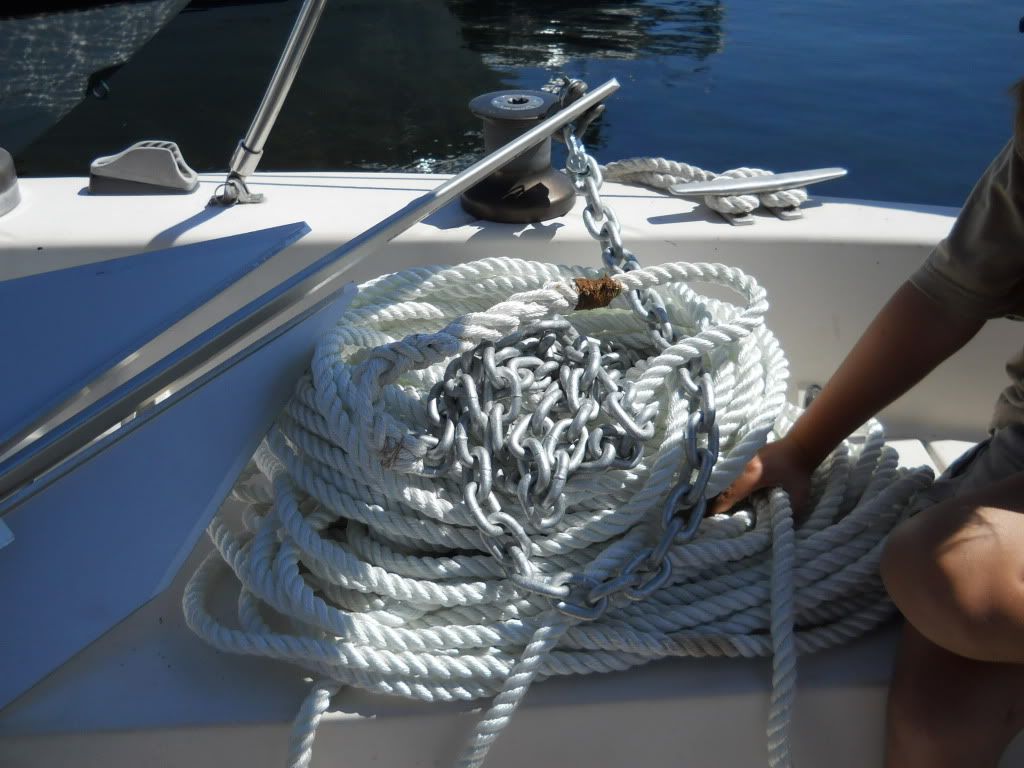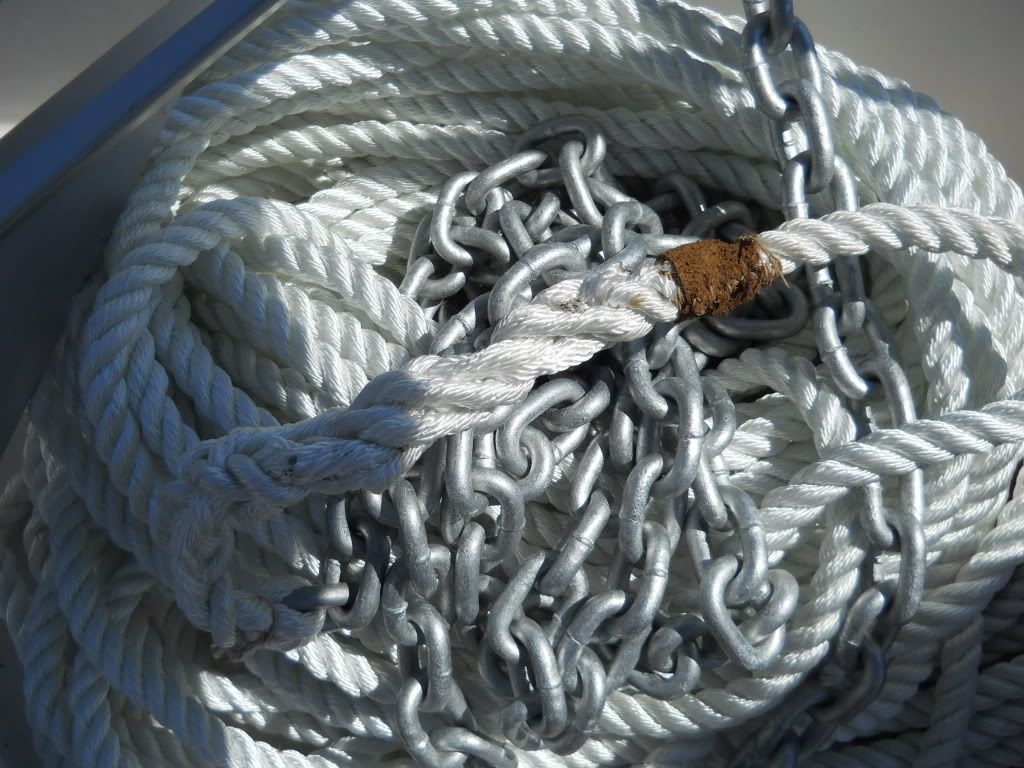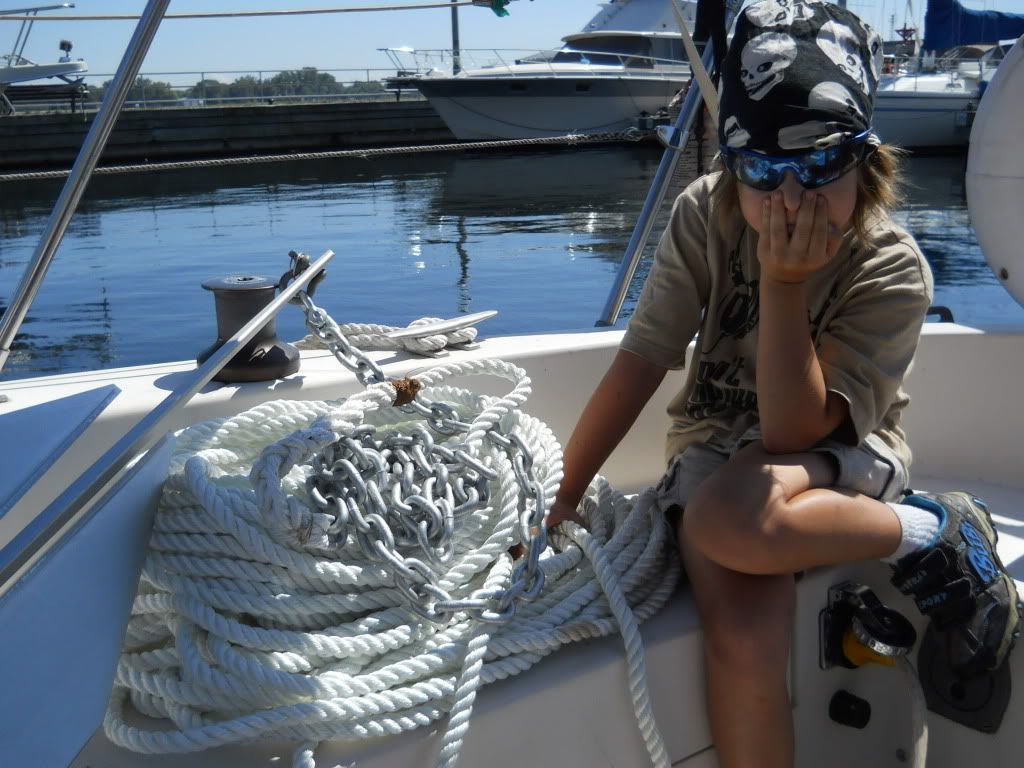
I have, as I believe I've mentioned, obtained a nifty 15 pound aluminum FX-23 from the fine folk at Fortress Anchors. It's designed for 39-45 feet LOA boats, like what my currently beached Alchemy is, and is therefore oversized for Valiente, my 9,000 lb., 33 footer that is the "operational" part of our Swiss navy.
C'est la vie: Nobody ever resented an oversized anchor that weighed 15 lbs. My nine-year-old can hoist it into the cockpit if I don't mind buffing out scratches. My compact spouse can haul away without resorting to the seaman's vocabulary.
The existing 13 foot chain and 200 foot rope rode on Valiente is three-strand 7/16" mated to slightly larger chain and shackled to a 22 lb. steel Danforth High Tensile anchor of indeterminate age, if relatively good condition. Certainly, it's the classic "lunch hook" and we've been using it as such. It has held in every unchallenging case we've thrown at it, which is to say it might as well have been a cinder block on 12 gauge wire for all the holding power demanded of it.
In testing the larger, if lighter, Fortress on this modest rode, however, we found it impossible to veer out in reverse under power, "under power" in this case being understood to mean a direct-drive Atomic 4 (about 17 HP) in reverse spinning an 11.5 x 8 inch Gori folding two-blade prop at 1:1 gearing in six knots of wind...not exactly a tractor pull. Nonetheless, we were concerned that the new, grippier anchor and the old rode were not a good match, so off to the marine store I went (And Princess Auto, like a marine store, only cheaper).
Not only did I want the security of a right-sized rope and chain (and shackles) rode for the Fortress's size, I wanted the opportunity to splice. 12 years of boat ownership, and it's never come up, even though I have sewed patches, reeved all sorts of line and have sealed, whipped and knotted many, many things. I have yet to SCUBA, too, but that's another post.

Obviously, more practice is required. I did test the thing, however, and 'backspliced' a full 18 inches, with three tucks before trimming instead of two. My biggest challenge was keeping the taped strands similarly twisted as they preferred to undo into a sort of yarn-like limpness, hence the somewhat irregular braiding. I suspect that this will actually look a bit better after use, and next time, I'm going to heat-shrink the ends instead of taping. The brown bit of leather is covering a spot of whipping I did to cover over the last pokey strands, and I did the recommended touch up with the recommended hot knife. It took about 90 minutes. I know, because that's how long my son whined "is it done yet?" from the shady, beveraged-filled cabin while Daddy paid court to Madame Melanoma in the sun-drenched cockpit, the scent of burning nylon vying with the smell of dead carp. Sailing: Come for the glamour, stay for the slaving.
The new rode is 200 feet of 5/8" three-strand with an 18-inch back splice (as this is my first, it's a little lacking in art and is untidy) to 15 feet of 3/8" chain. Shackles hold the anchor to the chain. This gives us 7:1 scope in 30 feet of water with a little left over, which is going to suffice 90% of the time in the Great Lakes and pretty close to 100% of the time in Lake Ontario.
I will leave the Fortress unshackled from the rode as they are awkward to move together. I also have made provision for the lashing of a light line leading to a float to go on the crown of the Fortress as an anchor buoy and, if ever needed, a trip line if we snag a log or something. I have not yet had a problem, however, merely driving over the anchor as I haul in rode and just yanking the anchor directly up. It comes up cleanly and the chain/rope/anchor combo is, I would say, less than 40 pounds...not a big deal for us and there's no budget for a windlass!

Note the expression of the crew when hearing the familiar refrain of "no budget for that".
We will likely use the existing "nothing wrong with it and it fits the anchor hangers" Danforth for a lunch hook, and bring out the Fortress and this new rode for overnight and heavy weather. As I intend it to be the lunch hook for Alchemy, it's certainly sturdy enough, and we anticipate sleeping soundly at anchor when we go down the lake in a couple of weeks.





10 comments:
The FX-23 is a replacement for only a 28 pound plough. Fortress is not well known for resetting after a wind shift. Backing down with your 17hp Atomic and two blade folding prop is not much strain at all...only 340 pounds...not anywhere near the wind force on your boat in a 30kt squall. Lake Ontario is not a pussycat compared to Caribbean and US coastal waters. Silverheels III is only 35ft and we use the Fortress with 18ft chain/225ft rope as a kedge anchor only. Strangely enough, Fortress manual wants you to set at 2:1 in soft mud, then veer out more rode.
I'm aware backing down is not a good test, and that the Fortress, like its Danforth kin, can fail to reset.
I have a 33 lb. Bruce and a 33 lb. CQR to bring with me if I suspect heavy air in an anchoring situation. The main point is that now I have a rode setup equal to those anchors as opposed to the dinky lunch hook setup I carried to this point. Which is fine off Hanlan's, admittedly, in light air.
The Fortress is frequently recommended as a good secondary or storm or as a kedge as you use it, because it's easy enough to row out or lob off the stern.
The Fortress can set at two angles, a 32 degree "normal" and an 45 degree "mud" setting...it just needs a wrench to adjust. I haven't used it in mud yet, and so can't attest, but I know it holds in pretty short scopes I wouldn't personally favour, but it comes loose easily and cleanly once you come up on it.
All anchors have deficiencies, of course. The Fortress is no exception, but it is quite good for what I'm asking of it at this stage...straight-line pulls. Veering or resetting are a different case needing a different approach, or even two anchors out of different kinds, assuming you have the room to deploy 'em.
Anyway, I feel good about it on this new rode, which is over-specced for a light 33 footer.
Next up is fashioning a bridle/snubber to fit, I guess.
We made up two 5/8 inch laid nylon snubber lines approximately 15ft long with 3-1/2 turns around a large rubber dogbone snubber on each line. The steel chainhooks lasted 1-1/2 years in salt water anchoring. Stainless chain hooks may be a better idea but plain chain hooks, even properly sized for the chain, often come off the chain when there's no tension on windless days when the chain hangs straight down from the roller. In Martinique we purchased Wichard Snap Hooks http://www.wichard.com/fiche-A%7CWICHARD%7C2986-0202040803000000-IM.html with a clever spring-loaded pin to help prevent accidental release. The pin seems undersized and could bend or corrode in the closed position. Jury's out on these things. That HMP single notched plate for both snubber lines is very difficult to deploy and so we sold it away before we had left the Hudson River. Snubber lines should be 3- strand nylon for elasticity and not too large in diameter in order to take advantage of it's shock absorbing qualities. In our opinion those fancy deck mounted chain stoppers are at least superfluous and possibly dangerous. Some boaters use only one snubber line which runs over the roller beside the chain. Our bobstay wouldn't like that arrangement. Chafe protection on snubber lines where they cross the toerail are important. We started out with sewn-on leather protectors, but as they were not adjustable and became salt and sun damaged we now use polymer fire hose type sleeves. Some cruisers don't use any rope snubbers at ALL! (Steel and aluminum boats?)
Yes, that's pretty well the sort of snubbers I wish to make. I too am undecided about how to hook the snubber to the chain in a way that it stays on, and despite generally liking Wichard gear, I find the idea of a little spring mechanism getting dipped in seawater all the time a laughable concept. If they manage to survive longer than the SS hooks, let me know, as they might just prove to be a "cost of doing business" item.
Re: chafe. I don't see why I WOULDN'T use rope snubbers, even with my beefier foredeck. I have chocks and bollards sized to accept them easily, and the fact that it's steel bar doesn't mean I don't get chafe. Also, the point is to reduce loads (and noise) on the chain, right? Snubbers/bridles do this admirably.
I have a heavy plate at the stem waterline with a hole for the bobstay and a second, lower hole for a snubber there. That would bring the "tug" off the deck and down in the water. Still trying to figure out how to rig that, and probably won't suss it out until many days at anchor in Alchemy.
I have been trying to find the Toronto fire department official in charge of "old firehose" for exactly this reason. Still looking.
Thanks, Ken. I appreciate the benefit of your experience.
A waterline stem attachment for the rope snubber is a great idea. It also reduces the amount of chain req'd for putting out enough chain for proper scope. Most folks using this method have two permanent snubbers spliced to a shackle at that strong point at the stem's waterline. They just drape them up and over the bow when underway.
Yep, that's the general idea. I can't take credit for it...the boat was designed that way by the original owner/builder, but I don't intend to ignore it. It's a half inch thick plate about four inches by three, with a 1/4" pair of bolt holes, the upper of which secures the stay in a turnbuckle fork and pin. I may enlarge the snubber hole.
Regarding chafe material check places that sell hydraulic hose.
I bought what I think you are talking about to cover some remote oil filter hose that I had to replace because of chafe.
Bill Kelleher
An interesting comment, Bill, as one of the customizations I'm doing on the new engine is to have a remotely mounted oil filter. I intend to mount it vertically on a bulkhead instead of horizontally as it comes on the engine so as to minimize spills. It hadn't struck me that this particular hose could be subject to chafe, but it would be very unpleasant indeed were it to start spewing hot, pressurized oil while operating.
Thanks for the tip.
I feel I should say that the oil line that I had problem on is on Detroit diesel that was 25 years old at the time I had the problem.
When I bought the new oil line's and told the person helping me what happened he suggested this hose as a chafe cover.
Bill Kelleher
Thanks for the clarification, Bill.
I considered a Detroit diesel or particularly a Cummins as a new engine based on my concept of motoring at 2100 RPM for ages and wanting big and torquey to turn my four-bladed wheel, but the smallest Cummins is 75 HP and I was at 52HP.
So I got the 60 HP Beta Marine and we'll see if that was a good idea. It should fit pretty well.
Post a Comment